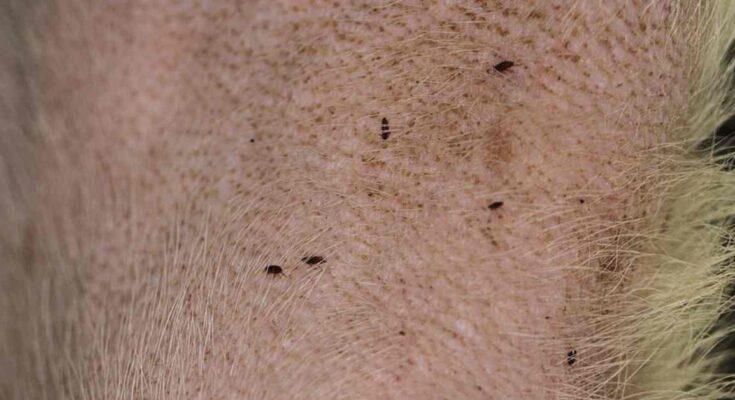Introduction
What Do Fleas Look Like: Fleas are tiny, yet highly troublesome pests that can cause significant discomfort to pets and humans. Understanding what fleas look like is crucial for effective identification and eradication. This comprehensive guide will delve into the appearance of fleas at various life stages, their behaviors, and how to spot an infestation.
Flea Anatomy: A Detailed Description
Fleas belong to the order Siphonaptera, which includes over 2,500 species. They are wingless insects known for their ability to jump great distances. Here’s a breakdown of their anatomy:
Size and Shape
- Adult Fleas: Typically, adult fleas measure about 1.5 to 3.3 mm in length. They are laterally compressed, meaning their bodies are narrow when viewed from the front. This flattened shape allows them to move through the fur of their hosts easily.
- Larvae: Flea larvae are around 2-5 mm long. They are legless, white, and resemble tiny worms. Unlike adults, larvae do not feed on blood but rather on organic debris, including adult flea feces.
- Pupae: The pupal stage is encased in a cocoon that is often camouflaged with debris from the environment, making it difficult to spot.
Color
- Adult Fleas: They are typically reddish-brown or dark brown. The color can vary slightly depending on their species and whether they have recently fed.
- Larvae: White or translucent with no discernible body segments or pigmentation.
- Pupae: Often difficult to see due to the cocoon’s ability to blend into its surroundings.
Body Parts
- Head: Fleas have a small head with piercing and sucking mouthparts designed to extract blood from their hosts. The head also has a pair of antennae.
- Thorax: This is divided into three segments, each with a pair of legs. Fleas possess powerful hind legs that are adapted for jumping.
- Abdomen: The abdomen is the largest part of the flea’s body, consisting of multiple segments that expand when the flea consumes blood.
Flea Life Cycle
Understanding the flea life cycle is essential for identifying them at various stages:
- Egg: Flea eggs are tiny, white, and oval-shaped, about 0.5 mm in length. They are laid on the host but often fall off into the environment.
- Larva: After hatching from the eggs, larvae emerge. They are about 2-5 mm long, white, and legless, with a worm-like appearance. They feed on organic debris.
- Pupa: The larva spins a cocoon and enters the pupal stage, where it develops into an adult. The cocoon can be sticky and gather debris, making it hard to detect.
- Adult: The adult flea emerges from the cocoon and begins seeking a host to feed on. This stage is characterized by the flea’s well-known jumping ability and reddish-brown color.
Flea Behavior and Habits
Movement
Fleas are renowned for their jumping capabilities. They can jump vertically up to 7 inches and horizontally up to 13 inches, which is about 200 times their body length. This ability aids them in moving between hosts and finding new ones.
Feeding
Adult fleas feed on the blood of their hosts. They have specialized mouthparts designed to pierce the skin and extract blood. Fleas prefer warm-blooded animals, including dogs, cats, and humans. Their bites can cause itching, irritation, and in some cases, allergic reactions.
Reproduction
Fleas reproduce rapidly. A female flea can lay up to 50 eggs per day, and in her lifetime, she can produce over 2,000 eggs. This high reproductive rate makes flea infestations difficult to control once they start.
Identifying Flea Infestations
Recognizing a flea infestation early is crucial for effective treatment. Here are some signs to look for:
On Pets
- Excessive Scratching: Pets infested with fleas will scratch and bite at their fur frequently due to the irritation caused by flea bites.
- Flea Dirt: Flea dirt, or flea feces, appears as small black or reddish-brown specks on your pet’s skin and fur. When placed on a damp paper towel, flea dirt will dissolve into a reddish-brown stain, indicating the presence of digested blood.
- Hair Loss and Skin Irritation: Flea bites can cause allergic reactions, leading to hair loss, redness, and inflammation.
In the Home
- Flea Eggs and Larvae: Look for tiny white eggs and larvae in your pet’s bedding, carpets, and upholstery.
- Flea Bites on Humans: Flea bites on humans appear as small, red, itchy spots, often around the ankles and lower legs.
- Sightings of Adult Fleas: Seeing adult fleas jumping on your pet or in your home is a clear sign of an infestation.
Flea Control and Prevention
Effective flea control involves a combination of treating the infested animal and the environment. Here are some strategies:
On Pets
- Topical Treatments: These are applied directly to the pet’s skin and can kill fleas on contact. Popular options include products containing fipronil or imidacloprid.
- Oral Medications: Oral flea treatments, such as those containing nitenpyram or spinosad, work quickly to kill fleas.
- Flea Collars: Flea collars release chemicals that repel or kill fleas. Some newer collars can provide protection for several months.
In the Home
- Vacuuming: Regularly vacuum carpets, rugs, and upholstery to remove flea eggs, larvae, and adults. Dispose of the vacuum bag immediately after use.
- Washing: Wash pet bedding and any other washable items in hot water to kill fleas and their eggs.
- Insecticides: Use insecticides designed to kill fleas in the home. Look for products containing ingredients such as permethrin or methoprene.
- Flea Traps: Flea traps can help reduce the number of adult fleas in your home by attracting and capturing them.
In the Yard
- Environmental Treatments: Apply flea control products to your yard, especially in areas where your pet spends time.
- Keep Grass Short: Fleas thrive in tall grass and shaded areas. Keeping your lawn well-trimmed can help reduce flea populations.
Fleas vs. Other Pests: How to Tell the Difference
Fleas can be mistaken for other small pests. Here’s how to distinguish them:
- Fleas vs. Bed Bugs: Bed bugs are oval-shaped and reddish-brown but are flatter and lack the powerful hind legs that fleas have.
- Fleas vs. Lice: Lice are also wingless and feed on blood, but they are usually found clinging to the hair shaft and are more elongated.
- Fleas vs. Ticks: Ticks are larger, have eight legs, and do not jump. They attach themselves firmly to their host.
Health Risks Associated with Fleas
Fleas are more than just a nuisance; they can pose serious health risks:
- Flea Allergy Dermatitis (FAD): This is an allergic reaction to flea saliva, causing severe itching and skin lesions.
- Tapeworms: Fleas can carry tapeworm larvae, which can infect pets and humans if ingested.
- Plague: While rare, fleas can transmit the bacteria Yersinia pestis, which causes plague.
- Cat Scratch Fever: Fleas can carry Bartonella henselae, the bacteria responsible for cat scratch fever, which can infect both cats and humans.
Conclusion
Identifying fleas and understanding their life cycle, behavior, and the risks they pose is crucial for effective management and prevention. Regular monitoring, combined with appropriate treatments for pets, the home, and the yard, can help keep these persistent pests at bay. If you suspect a flea infestation, taking prompt action can save you and your pets from discomfort and potential health issues.




